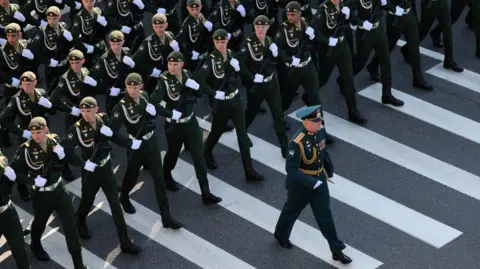On May 9, 2025, Russian President Vladimir Putin presided over the annual Victory Day parade in Red Square, an event meant to commemorate the Soviet Union’s triumph over Nazi Germany in World War II. This year, heightened security measures were implemented following a recent increase in Ukrainian strikes targeting Moscow, which raised concerns about potential disruptions during the celebrations. Putin’s rhetoric during the parade echoed themes of national pride and resilience, emphasizing the lessons learned from past wars while reinforcing the narrative supporting the ongoing military operations in Ukraine.
Among the attendees were notable world leaders, including China’s President Xi Jinping. In his address, Putin declared that “truth and justice are on our side,” framing the conflict in Ukraine as a necessary response to perceived threats. His characterization of the military campaign in Ukraine as a “special military operation” reflects a longstanding Kremlin narrative that has been firmly in place since the conflict escalated in 2022. He asserted that the entire nation of Russia stood united behind this effort, indicating widespread support for the actions being taken in Ukraine, which is now entering its fourth year.
In a significant move coinciding with the elaborate celebrations, Russia announced a unilateral three-day ceasefire intended to last through the commemorations. However, Ukraine rebuffed this gesture, labeling it a mere “theatrical show.” The Ukrainian military reported enduring thousands of attacks since the ceasefire formally began on May 8, contrasting sharply with Moscow’s insistence that the ceasefire was being honored and instead accusing Ukraine of violating it repeatedly.
As the ceasefire unfolded, tensions remained palpably high. In the days preceding the parade, both Moscow and Kyiv exchanged heavy fire, leading to the cancellation of flights across Russia and stranding around 60,000 passengers due to drone strikes. In central Moscow, stringent restrictions were put in place to ensure the safety of the parade’s participants and spectators amid fears of heightened threats.
The parade itself was attended by 27 world leaders. Among the prominent figures were Brazilian President Luiz Inácio Lula da Silva, Venezuelan President Nicolas Maduro, Serbian President Aleksandar Vučić, and Slovakia’s Prime Minister Robert Fico, the sole leader from the European Union present at the event. Notably absent were other European leaders, following statements from the EU’s foreign policy chief that discouraged participation due to Russia’s escalating war efforts in Ukraine.
The significant presence of military personnel—11,000 soldiers marched in Red Square to showcase Russia’s latest military hardware—underscored the event’s dual purpose: honoring historical sacrifices while promoting contemporary military prowess. Chinese soldiers also participated in the parade, highlighting the strengthening of ties between Moscow and Beijing amidst global geopolitical tensions.
In the backdrop of these events, Ukrainian President Volodymyr Zelensky publicly warned against attending the parade, stating he couldn’t guarantee the safety of any visiting dignitaries. Analysts in Ukraine, such as military expert Mykhailo Samus, suggested that Ukraine would refrain from attacking the parade due to the presence of foreign leaders, but he also pointed out that any attack could be seen as a legitimate military target.
Zelensky’s administration has repeatedly rejected the ceasefire agreement proposed by Putin, viewing it as a ruse. He offered a counter-proposal for a longer 30-day ceasefire to facilitate a more meaningful dialogue toward peace and emphasized the need for genuine accountability from Moscow regarding its military operations. Conversations between Zelensky and U.S. President Donald Trump also indicated an ongoing commitment from Ukraine to seek resolutions through diplomatic means, demonstrating the complexities of the situation amid ongoing conflict.
In summary, the commemoration of Victory Day in 2025 reflected not only Russia’s historical pride but also the contemporary tensions surrounding the protracted conflict in Ukraine. The nuances of military actions, international diplomacy, and the stark contrast of narratives from both nations emphasize the deep-rooted challenges beside the symbolic gestures of peace and unity.



